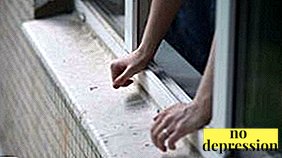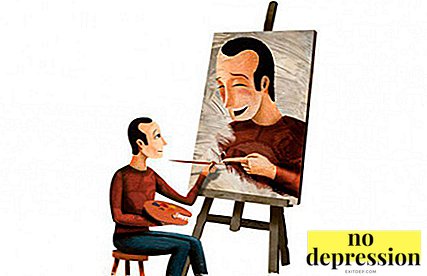The phenomenon of sleepwalking is known to science for a long time.
A similar sleep disorder is diagnosed. not only adults but also children.
Determining the causes of the problem in a particular patient often helps to eliminate the signs of illness.
Notion of sleepwalking

Who are the lunatics?
Sleepwalking (somnambulism) is a painful disorder in which people who are in a state of sleep perform various actions.
In areas of the brain, foci of arousal are formed when the body is not fully awakened from the deep phase of slow sleep.
Sleepwalking is painful condition since during its manifestation a person may put himself in grave danger: grab sharp objects, go outside the door, approach an open window, etc.
Typically, sleight attacks do not last long - from 30 seconds to 30 minutes. In rare cases, their duration increases to several hours.
After awakening, people do not remember anything that happened to them. If the memories are present, they are distinguished by their abruptness and illegibility.
This is because the lunatic during attacks memory does not record occurring events. There is also a theory that memories are absent due to a violation of the process of their extraction from memory.
Statistics show that in most cases people with sleepwalking, perform in their unconscious state extremely simple actions: talking, walking, taking a sitting position, etc.

Nevertheless, there were more than once recorded cases by lunatics of fairly complex actions: eating, driving a car, moving furniture in a house, etc.
Such cases confirm the fact that even with unconscious behavior a person able to coordinate their actions.
Causes of walking in a dream
The causes of somnambulism in children and adults differ. In children, the problem is more common. It is caused mainly by the immaturity of the psyche, impressionability and gradually disappears with age.
Adults suffer from sleepwalking much less often. It occurs in the presence of primary diseases, mental problems. So, neurotics are often prone to sleepwalking.
In children
What makes a child sleepwalking? The problem may be systematic or manifest at the hotel moment due to the impact of a factor. Basically children suffer from sleepwalking for the following reasons:
- lack of sleep;
- lack of sleep;
- high fever during illness;
- stress condition;
- increased anxiety;
- primary diseases that provoke the appearance of a problem (apnea, epilepsy, restless legs syndrome);
- urination;
- nightmare;
- genetic predisposition;
- head injuries;
- migraine;
- medication intake.

In adults
In adulthood, as a rule The problem appears under the influence of more serious factors:
- intoxication of the body;
- alcoholism;
- addiction;
- disorders of the brain.
With the appearance of severe symptoms of the disorder, you should seek help from specialists. At the same time, the treatment of the factor causing sleepwalking is of key importance.
Signs and symptoms

The symptoms of sleepwalking include the following Behavior during sleep:
- walking, performing various actions (dressing, eating, etc.);
- active speech or indistinct mumbling;
- performing repeated actions or repeating the same words, phrases;
- lack of memory of your behavior after waking up;
- committing inappropriate, strange actions;
- manifestation of aggression, cruelty;
- screams associated with nightmares;
- lack of response to the treatment of other people to the questions they ask;
- clumsiness of movements;
- if the eyes are open, they seem dull, glassy;
Thus, an adult or a child may go to bed and suddenly in the middle of the night, being in a state of sleep, begin to perform various actions.
At the same time, the person will do his usual movements absolutely unconsciously, and after awakening remember nothing about it.
Diagnosis of somnambulism

What if you are a lunatic? Overall somnambulism not considered a malignant disease.
Its rare manifestations do not affect the quality of life of people suffering from it. Often, the problem passes without a trace by itself without any treatment.
But to consult a doctor for advice on such problems. Often, prescribing sedatives and making recommendations for lifestyle changes help to resolve the issue.
A more difficult situation develops when the seizures recur with a certain regularity, last for a long time or during sleep. man is a danger to himself.
In this case, recourse to specialists is mandatory.
For an accurate diagnosis, the patient is prescribed the following examinations:
- electroencephalography (study brain activity);
- polysomnography (the patient is placed overnight in a special laboratory, where, with the help of sensors, data is obtained about the features of his sleep);
- Ultrasound cerebral vessels (determined by the nature of blood flow);
- MRI (the study is conducted in order to identify possible neoplasms or other pathological processes that have served as a provoking factor for the appearance of sleepwalking);
- examination of related professionals (endocrinologist, cardiologist, etc.) to establish the presence of diseases that could be the cause for the development of sleepwalking.
Principles of treatment

How to get rid of sleepwalking?
Not all patients with this disorder need treatment.
If slithering has developed under the influence of external factors, it appears quite rarely and does not cause any problems to a person, then its manifestations can be excluded by minimizing the impact of negative factors.
How to deal with somnambulism? Recommended take the following measures at home:
- Adjust the sleep mode. Full sleep should be at least 7-8 hours per day in an adult. In a child, this figure leaves 8-9 hours. In this case, the dream should be regular, deep and quality.
- At bedtime, perform relaxing treatments. This could be a massage, a bath, aromatherapy, listening to your favorite music, etc.
- To eliminate the effects on the body of the computer, TV a couple of hours before bedtime. A person who until late evening sits in front of the TV or computer monitor goes to bed in an excited state.
This factor is especially negative for children whose psyche is more susceptible to arousal.
- Stop drinking late in the evening. This kind of relaxation after a hard day’s work can cause sleep disorders.
- Learn to resist stress. A modern person lives in a state of constant emotional stress: difficulties at work, domestic problems, material difficulties, etc. It is important to learn to abstract from minor troubles, not to take them to heart.

How to stop constantly sleeping at night?
In cases where sleepwalking became a consequence of more serious problems, you need to seek help from specialists.
The doctor will diagnose and identify the causes that prompted the development of sleepwalking.
Usually The treatment is based on the following principles:
- cancellation or reduction of the dosage of strong drugs taken by the patient;
- administering antiepileptic drugs to people suffering from epileptic seizures;
- administering tranquilizers, antidepressants to patients suffering from neurosis;
- conducting hypnosis sessions;
- prescription of benzodiazepine medications;
- treatment of existing mental disorders that caused the development of sleepwalking.
How to avoid injury?
For people around them, lunatics usually pose no danger. Perhaps the manifestation of an aggressive reaction in the case of a forced waking up from sleep during an attack.
In this case, a person can react negatively to the person who woke him. But, in general, somnambulists are a danger only to themselves.

During unconscious movement around the house or going out into the street they can cause themselves serious harm.
It is important for close people to take precautions to protect a person from possible negative consequences his sleepiness.
Recommended do the following:
- Do not wake a sleeping person. This can lead not only to the manifestation of aggression on his part, but also to strong fright from an abrupt awakening. If the sleepwalker is at rest, you can just gently direct it towards the bedroom and gently lay on the bed. If the behavior is aggressive, you should step aside and just follow its movements.
Usually night walks do not last long, so such observations will not take much time.
- Remove obstacles on the way. While the lunatic is moving through the house, you need to ensure that no obstacles arise in its path. It is necessary to move objects in time, remove chairs, etc. If a large obstacle (for example, a closet) is located along the route, you should carefully adjust the direction of the sleeper's movement.
- Lock the doors and windows for the night. This point is key to security. An attack of sleepwalking can happen when a person is alone at home or during a good sleep for all loved ones.
 In this case, an open window or door can be a source of increased danger: a sleepwalker can fall out of the window or go out through the door to the street. For this reason, you need to use not just standard latches that a person can easily open. It is advisable to use reliable locks, grilles and other devices that are guaranteed to eliminate unpleasant developments.
In this case, an open window or door can be a source of increased danger: a sleepwalker can fall out of the window or go out through the door to the street. For this reason, you need to use not just standard latches that a person can easily open. It is advisable to use reliable locks, grilles and other devices that are guaranteed to eliminate unpleasant developments. - Hide all dangerous items. Any piercing and cutting objects are also a source of increased danger. A person can get hurt by himself or, in the case of aggressive behavior, unknowingly harm his loved ones.
At bedtime, knives, forks, glasses, etc. should be removed to inaccessible places.
- Secure the ladder. In private homes, the danger is a ladder from which you can fall in a dream. If there is a staircase, a partition should be made in front of it, which will block the exit for the night.
So sleepwalking is a common mental disorder. Often it does not pose a danger to humans and passes on its own. In severe cases, it is important to undergo a diagnosis and apply appropriate treatment.
Who are the lunatics:

 In this case, an open window or door can be a source of increased danger: a sleepwalker can fall out of the window or go out through the door to the street. For this reason, you need to use not just standard latches that a person can easily open. It is advisable to use reliable locks, grilles and other devices that are guaranteed to eliminate unpleasant developments.
In this case, an open window or door can be a source of increased danger: a sleepwalker can fall out of the window or go out through the door to the street. For this reason, you need to use not just standard latches that a person can easily open. It is advisable to use reliable locks, grilles and other devices that are guaranteed to eliminate unpleasant developments.

